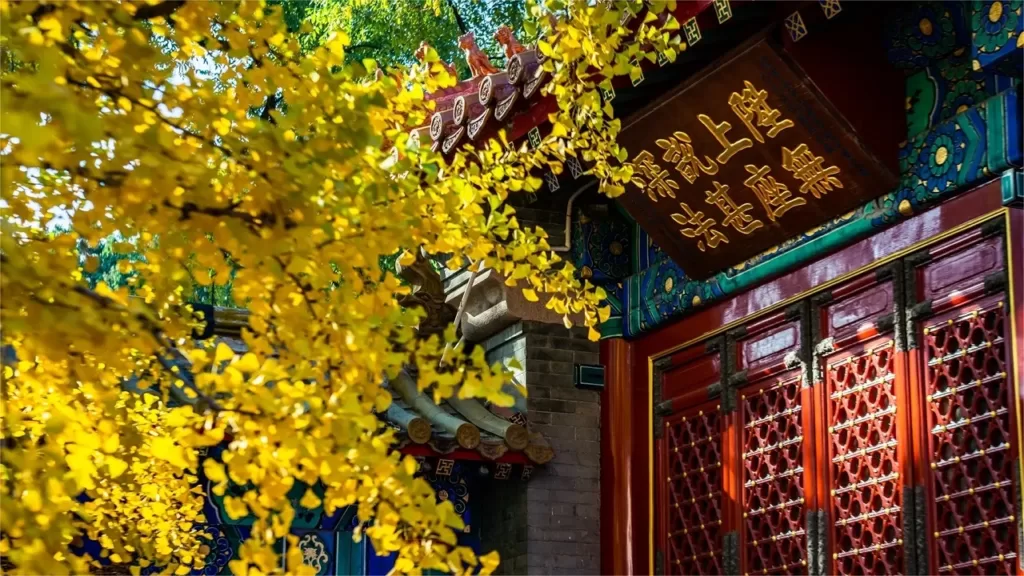Badachu Park (八大处公园), located adjacent to the Xishan Forest Park in Beijing, spans an expansive 332 hectares with its highest peak reaching an elevation of 464 meters. The name “Badachu” refers to the eight Buddhist temples scattered throughout the park, each with a rich history and a strong tradition of devout worship, making it a renowned destination for Buddhist prayers and blessings in the outskirts of Beijing. The park is adorned with numerous gingko and maple trees, presenting a breathtaking display of red and yellow foliage during the autumn season. In spring (March-April), the slopes beneath Hutou Peak burst into a sea of apricot blossoms, resembling a scene of fluttering auspicious snow.
The park’s terrain, though not excessively elevated, features staircases winding through its landscape. The journey from the park’s entrance to the mountain’s summit spans approximately four to five kilometers, making it an ideal location for hiking and exercise. Climbing to the top may take 2-3 hours, while a more leisurely exploration involving visits to temples and scenic viewpoints could extend to 4-6 hours or even longer. Visitors from downtown Beijing should allocate a full day for the trip. For those with limited physical stamina or accompanied by elderly individuals or children, the park offers cable cars and slides within the area. The thrilling descent on the slide, especially from the mountaintop, provides an exciting experience, making it particularly suitable for families with young children.
Table of Contents
- Basic Information
- Hand-Picked Activities for You
- Location and Transportation
- Three Mountains of the Park
- Cuiwei Mountain (翠微山)
- Hutou Mountain (虎头山)
- Qinglong Mountain (青龙山)
- Eight Temples in Badachu Park
- Chang’an Temple (长安寺)
- Lingguang Temple (灵光寺)
- San shan Temple (三山庵)
- Da bei Temple (大悲寺)
- Longquan Temple (龙泉庵)
- Xiangjie Temple (香界寺)
- Baozhu Temple (宝珠洞)
- Zhengguo Temple (证果寺)
- Vlog about Badachu Park
- Find the Best Hotel near Badachu Park
- Useful Tips Summarized from Reviews
- Other Temples in Beijing
Basic Information
| Website | http://www.badachu.com.cn/ |
| Estimated Length of Tour | Over 3 hours |
| Ticket Price | 10 RMB |
| Opening Hours | 6.00 – 19.30; Last admission: 18.30 (16th March – 31st August) 6.00 – 19.00; Last admission: 18.00 (1st September – 15th November) 6.00 – 18.30; Last admission: 17.30 (16th November – 15th March the next year) |
| Telephoen Number | 0086-010-88964661 |
Hand-Picked Activities for You
Location and Transportation
Badachu Park is located in the western suburbs of Beijing, China, near the Fragnant Hills and Beijing Botanical Garden. The exact address of the park is No. 9, Badachu Road, Shijingshan District, Beijing. The park is easily accessible by public transportation, with several bus lines nearby.
Bus: Take bus 347, 489, 958, or 972, get off at Badachu South Stop (八大处南站), and then transfer to the shuttle bus to reach the park.
Three Mountains of the Park
Cuiwei Mountain (翠微山)

Cuiwei Mountain, historically known as Pingpo Mountain, stands at an elevation of 464 meters within Badachu Park. Adorned with lush green pines and cypress trees that remain evergreen throughout the seasons, the mountain is home to significant ancient temples, including Sanshan Temple, Dabei Temple, Longquan Temple, Xiangjie Temple, and Baozhu Temple. As the central and highest peak in the park, Cuiwei Mountain forms the core of Badachu Park, contributing to its spiritual and historical significance.
Hutou Mountain (虎头山)

Hutou Mountain, aptly named for its peak resembling a tiger’s head and the entire mountain resembling a reclining tiger, stands at an elevation of 387 meters within Badachu Park. Historically known as Jueshan Mountain, the eastern foothills are graced by the presence of Chang’an Temple and Lingguang Temple, adding to the historical and cultural richness of the mountainous landscape.
Qinglong Mountain (青龙山)

Qinglong Mountain, with an elevation of 438 meters, winds gracefully from the northwest to the southeast in a manner reminiscent of a coiled azure dragon. Its eastern slope, known for the legendary Lu Shi Mountain, is famous for the tales of Monk Lu Shi. The mountain is rich in cultural heritage, hosting sites such as Zhengguo Temple, as well as the remnants of Qingshui Temple, Hongde Temple, Hongfu Temple, Fuhui Temple, and the Lion’s Den Pagoda. The profound cultural significance of Qinglong Mountain contributes to the historical allure of Badachu Park.
Eight Temples in Badachu Park
Chang’an Temple (长安寺)

Chang’an Temple, which is also known as Shanying Temple and Shanying Chang’an Zen Forest, was the first temple established in Badachu Park. It was built in the 17th year of the Hongzhi reign of the Ming Dynasty (1504) and underwent two renovations during the 16th year of the Shunzhi reign (1659) and the 10th year of the Kangxi reign (1671) of the Qing Dynasty. Over time, the halls and buildings have been refined, and the temple has become renowned for its collection of Buddhist statues and artifacts, making it one of the most famous temples in the West Mountain area during the Ming and Qing Dynasties. Even after five centuries, the ancient Chang’an Temple has retained its original architectural layout.
Lingguang Temple (灵光寺)
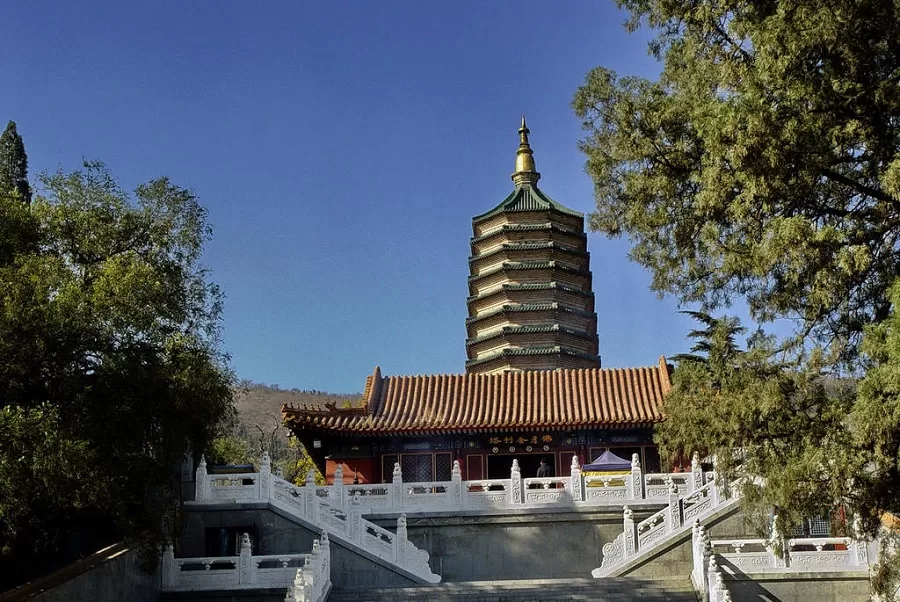
Lingguang Temple, the second temple in Badachu Park, is the most important and well-preserved temple of all. It was first established during the Dali period of the Tang Dynasty (766-779 AD) and was originally known as “Longquan Temple”. During the reign of Emperor Shizong of the Jin Dynasty (1162 AD), it was renamed “Jueshan Temple”. In the Xuande period of the Ming Dynasty (1428 AD), it was restored to its former name of Longquan Temple, and during the Zhengtong period of the Ming Dynasty (1436-1449 AD), it was expanded and renamed “Lingguang Temple”.
San shan Temple (三山庵)

Sanshan Temple is the third temple in Badachu Park, built during the third year of the Jin Dynasty’s Tiande period (1151). The main gate faces northeast and opens up to a courtyard with four quadrangles. The gate hall has three openings with a corner gate on each side. The main hall has five bays and is accompanied by two side rooms, while two auxiliary halls are located on both sides of the main hall. A plaque reading “Sanshan An” hangs above the gate hall.
Da bei Temple (大悲寺)

Da Bei Temple is situated on the mountainside between San Shan Temple and Longquan Temple. Legend has it that it was built during the Northern Song or Liao-Jin period (around 1033) and was originally known as “Yin Ji Temple.” The courtyard is divided into three sections and four quadrangles. The gate hall bears a stone plaque with the calligraphy of Emperor Kangxi of the Qing Dynasty, which reads “Imperial construction of Da Bei Temple.” The hall houses statues of the Four Heavenly Kings. Behind the gate hall is the main hall, where there are two bamboo ponds from the Ming Dynasty, which are lush and verdant. In the center of the main hall, there is a statue of the Three Buddhas, and on both sides are the statues of the “Eighteen Arhats,” which are believed to be masterpieces of the famous Yuan Dynasty sculptor Liu Yuan.
Longquan Temple (龙泉庵)

Longquan Temple, also known as Longwang Tang, is situated to the northwest of Da Bei Temple. It was first established as “Huiyun Zen Forest” during the Hongxi Yiji year of the Ming Dynasty in 1425. In the second year of the Qing Dynasty’s Shunzhi reign (1645), a clear spring was discovered on the site, and a temple dedicated to the Dragon King was built. During the Daoguang period of the Qing Dynasty, the two separate areas were combined into one and became known as Longquan An. The temple complex is made up of five courtyards divided into three levels: upper, middle, and lower.
Xiangjie Temple (香界寺)
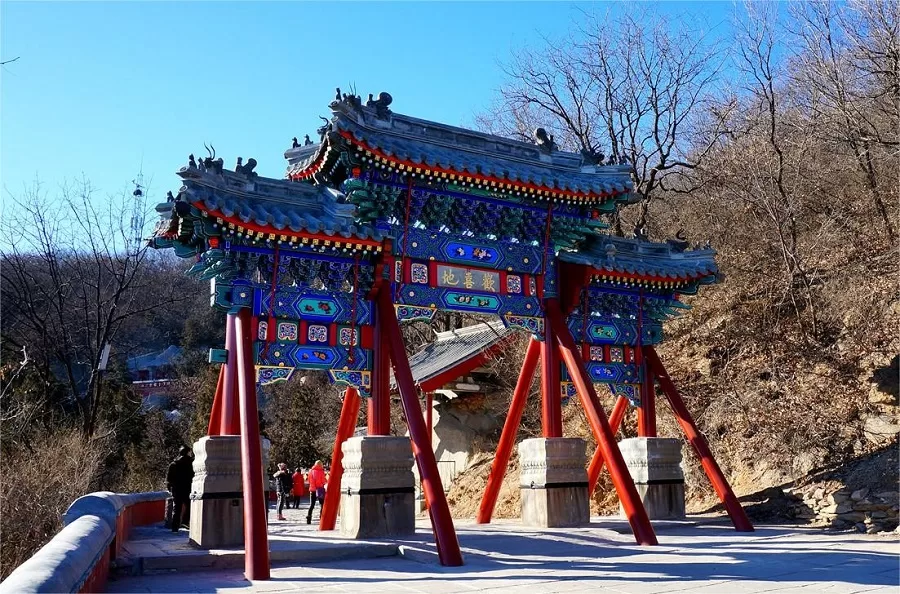
Xiangjie Temple, the largest temple in the Eight Great Sites, is situated on Pingpo Mountain. Its construction dates back to the Gan Yuan period of the Tang Dynasty (758-760), when it was called “Pingpo Dajue Temple”. During the Ming Dynasty, it was known as “Dayuantong Temple”, and “Shenggan Temple” during the Kangxi reign of the Qing Dynasty. It was finally renamed to its current name in the Qianlong period. Xiangjie Temple faces north and is oriented south, taking advantage of the mountain’s terrain to create a magnificent and grand appearance. It was a popular destination for emperors during their mountain excursions throughout history.
Baozhu Temple (宝珠洞)

Baozhu Temple is situated at the summit of Pingpo Mountain and was established in 1780, during the 46th year of the Qianlong reign in the Qing Dynasty. In front of the temple stands a wooden archway inscribed with calligraphy by Emperor Qianlong, reading “Jiangu Lin” (Firm Forest) and “Huanxi Di” (Joyous Land) on the inside and outside, respectively. Upon passing through the archway, visitors will notice a natural giant rock on the side of the road, where the cursive script of the “Baozhu Cave Poem” can be faintly seen. The signature on the poem bears the imperial seal of Emperor Qianlong.
Zhengguo Temple (证果寺)

Zhengguo Temple is the oldest temple among the Eight Great Sites. It was originally built during the Tianbao period of the Tang Dynasty (or during the Renshou period of the Sui Dynasty according to some accounts). Inside the temple, there is an ancient huanglian tree that is over 600 years old, a unique sight in Beijing. The mountain gate has dozens of stone steps, and the words “Ancient Temple Zhengguo Temple” are inscribed on a stone tablet under the steps, written by Emperor Yingzong of the Ming Dynasty. To the left of the mountain gate is a deep pool named Qinglong Pool, which is said to be the place where the Qinglong dragon appears and disappears.
Vlog about Badachu Park
Find the Best Hotel near Badachu Park
Useful Tips Summarized from Reviews
Cable Car and Slide: The park offers a cable car ride to the mountaintop, which costs 70 yuan for a one-way trip. Additionally, there is a slide, which is the longest in Beijing at 1700 meters, costing 100 yuan per ride. The cable car provides a convenient way to reach the summit, while the slide offers a thrilling descent.
Parking and Transportation: Parking is available only at the foot of the mountain. Visitors must ascend on foot or negotiate a fare for a tricycle ride to the top.
Encounter with Animals: Badachu Park is home to various small animals such as cats, dogs, monkeys, ducks, and fish. These animals are known for their gentle nature, providing visitors with an opportunity to observe and interact with them.
Vegetarian Restaurant: Adjacent to Lingguang Temple, there is a vegetarian restaurant where visitors can enjoy a meal. The average cost per person is around 50 yuan, and the dishes are appetizing and filling. It’s a great option for those looking for a vegetarian dining experience.
Scenic Overlook:
Near the starting point of the slide, there is a large platform that offers a panoramic view of Shijingshan Mountain. Take some time to admire the scenic beauty of the area and capture memorable photos of the landscape.
Other Temples in Beijing

Hongluo Temple – a temple blessed with breathtaking natural surroundings

Wofo Temple – a temple with a statue of a reclining Buddha

Dongyue Taoist Temple – the headquarter of Beijing Taoist Association
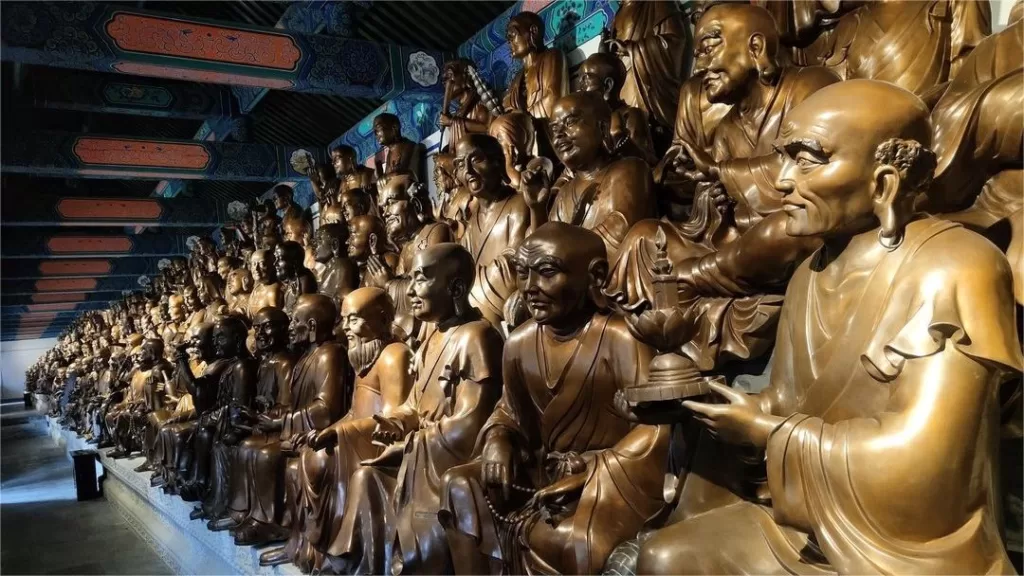
Jietai Temple – a temple situated at the foot of Jietai Mountain

Yonghe Lama Temple – a Tibetan Buddhist temple
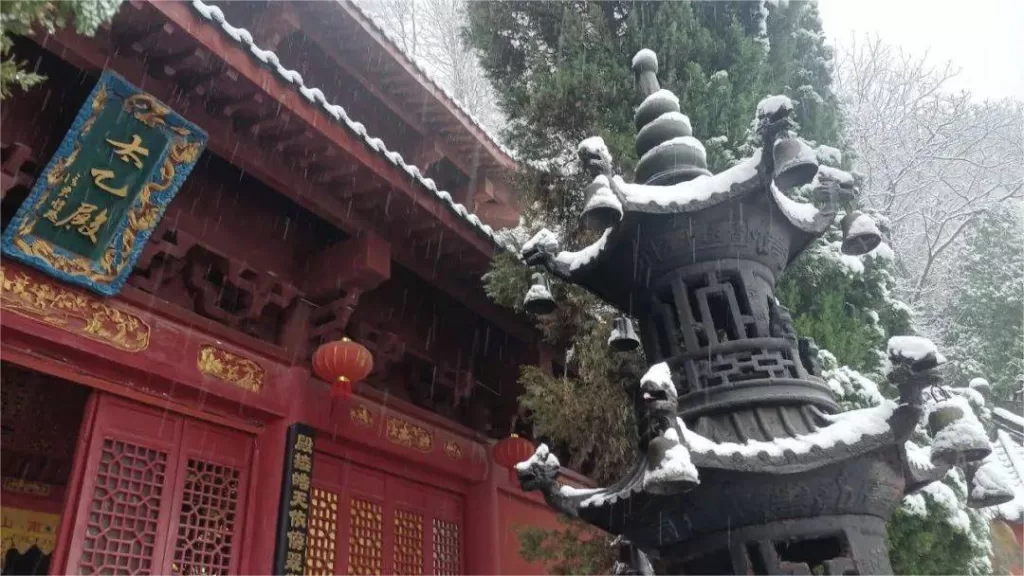
White Cloud Temple – a Tang dynasty Taoist Temple

